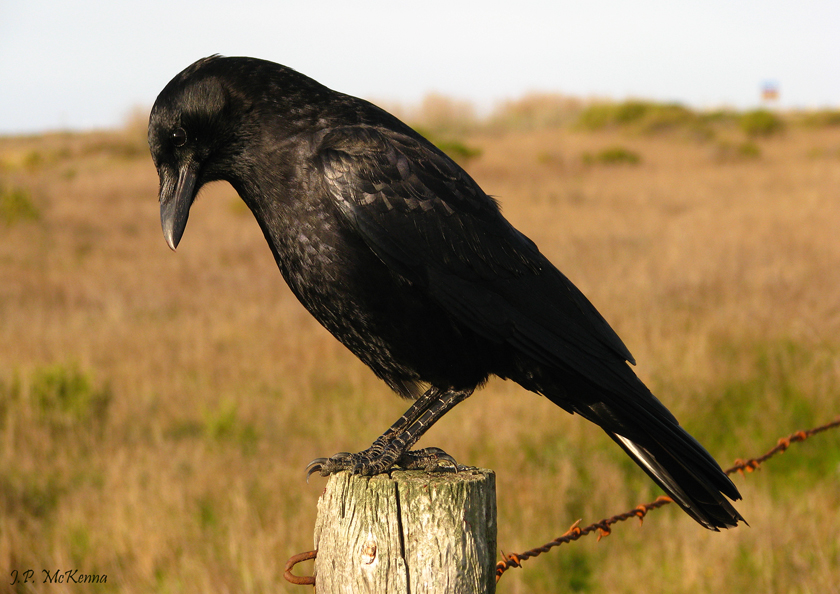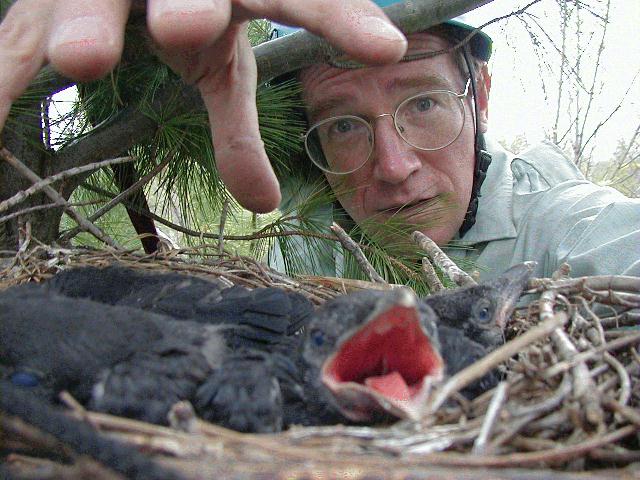People Who Feed Crows With Peanuts in the Shell
The Secrets Of Gift-Giving Crows
You may not receive a gift from crows in return for feeding them, as one family reports they did, but the experts say it's OK to share a snack with these smart, social birds.
By Vicki Croke

Joe McKenna/Flickr Creative Commons
It's an intriguing headline: "Seattle Girl Befriends Neighborhood Crows, Making Bird Lovers Everywhere Jealous."
It ran over Audubon online's story about Gabi Mann, an 8-year-old girl in Seattle who has befriended a group of crows in her neighborhood by putting food out for them. Gabi and her family report that for the past couple of years, in an exchange—or just out of pure friendship—the birds have been leaving the girl small, often shiny items, which the family says are gifts: small pieces of brown glass, a bead, a button, a paper clip. Her favorite is a little heart pendant.
As soon as I read that story, I wanted to know more about it, especially because I had had a fun friendship years ago with a group of crows in my neighborhood, a friendship that had been coached by Kevin McGowan, a crow expert with the Cornell Lab of Ornithology.
Vicki spoke with Here & Now's Robin Young about the incredible intelligence of crows (and how willing they are to make friends with us).
First, I read what John Marzluff, a crow expert and author, and professor of wildlife science at the University of Washington, had to say about this to the BBC News Magazine. He pointed out that crows do give gifts among themselves and that they certainly interact with people and quickly learn things when food is involved:
"If you want to form a bond with a crow, be consistent in rewarding them," advises John Marzluff, professor of wildlife science at the University of Washington. He specialises in birds, particularly crows and ravens…
Marzluff, and his colleague Mark Miller, did a study of crows and the people who feed them. They found that crows and people form a very personal relationship. "There's definitely a two-way communication going on there," Marzluff says. "They understand each other's signals."
The birds communicate by how they fly, how close they walk, and where they sit. The human learns their language and the crows learn their feeder's patterns and posture. They start to know and trust each other. Sometimes a crow leaves a gift.
But crow gifts are not guaranteed. "I can't say they always will (give presents)," Marzluff admits, having never received any gifts personally, "but I have seen an awful lot of things crows have brought people."
Next, I phoned "my" expert, Kevin McGowan at Cornell. He has never seen this kind of "gift giving" behavior among his study crows on the East Coast. Though he says that crows cache food, and young crows play with objects and cache things that aren't exactly food, like acorn caps.
I wondered if West Coast crows different than East Coast crows. And Dr. McGowan said there are differences in their social structure.
I know that crows certainly seem to display "cultural" differences between populations. And Marzluff and others have written at length about how amazing these birds are. They score as high as primates in some intelligence tests. They fashion and use tools.
How do you raise the water level in a tube to reach a treat? Clever crows figure out a solution fast:
[youtube=https://youtu.be/ZerUbHmuY04]
Crows in captivity will figure out how to fill a cup with water to moisten their food, or bend wire into a hook to lift a tiny bucket. In the wild they'll bring dry bread to a birdbath to soak and soften it. They may stack scattered crackers into a pile so they can carry the whole pile away. And in Japan, they place walnuts in front of stopped cars in an intersection and wait for the cars to go forward and crush the nuts. Then they swoop in and safely retrieve the nut meats.
They recognize individual human faces. They can mimic human voices. They're very social and they are terrific problem solvers.
I asked Kevin McGowan if it is OK to encourage people to feed crows and interact with them as this little girl in Seattle did (and as I once did myself).
With a few cautions provided, he said he's in favor of positive interactions between crows and people.
He's been studying the birds for 26 years, and he started feeding crows himself long ago in order to make up for what the crows perceived as his bad behavior. As part of his work, he would climb up to crow nests to weigh the babies, and the birds saw him as a nest predator.
"You get kind of paranoid after a while when you're driving around and crows yell at you," McGowan said, "so I decided I was going to try to make some of them like me and we started offering them peanuts and it turned out it's a good research tool actually, because it allows us to census families and so keep track of who's alive and that kind of stuff and make sure that we've actually found them and so we do use it not indiscriminately—in fact, I discourage people from doing a whole lot of heavy feeding of crows."

Kevin McGowan checking in on some baby crows. Courtesy of Cornell Lab of Ornithology.
McGowan first talked to me about that in 1998, and I immediately began to feed peanuts to the crows who would hang around the park where I brought my dog every day.
The birds very quickly—within a few days– recognized me—swooping over and calling to me—to get their handout.
They also recognized my car—and in a maneuver that I cherished, they would act like fighter jets escorting Air Force One: they'd glide right next to the driver window at head level, guiding me into my parking spot.
I hadn't spoken to McGowan in more than 15 years and I was eager to tell him about this. But when I excitedly described the escorting behavior, he said matter-of-factly–"standard." To him this was ho-hum.
But even if Kevin didn't make me feel special, the birds did. They made it clear that they had a relationship with me. I knew that because if someone else used my car to bring my dog to the park, the crows would not swoop down. They would stay back. They knew me specifically.

David Levinson/Flickr Creative Commons
Unfortunately, it appears that West Nile virus wiped out "my" crows soon after, as it did crow populations in a lot of places in the late 1990s. Dr. McGowan says some places lost 75 percent of their crow populations and in some areas they still have not recovered.
He saw many study birds die during this time. And for him it was personal. As he phrased it, he lost 35 birds that he had known since they were eggs. And these are animals who under the right circumstances can live a long time—one captive crow made it to the age of 59.
If you decide to befriend some crows near you, there are a few guidelines to follow to make sure you're being responsible:
*Feed them something healthy—unsalted peanuts, with or without the shells are recommended by the crow experts themselves.
*Don't throw the nuts AT them, and don't feed them too much. These are wild birds accustomed to gathering their own food—so a few peanuts are plenty.
*Also, make sure you're not luring these birds into a dangerous situation—a place where cars are coming or an area where neighbors might get angry about loud crows hanging around.
McGowan knows of a case where an angry neighbor shot some of the crows because they were loud and messy—dropping peanut shells. Dumping tons of food for wildlife can cause a problem.
It's easy to see why we are intrigued by crows. They seem a lot like us.
They're noisy, smart, and social. They're omnivores and opportunists. They mate for life. They can live in large extended families with the kids helping out around the nest. Young crows who have left for years will be recognized and welcomed back to the family. They have extensive vocalizations and vocabularies.
Kevin McGowan talks about what he calls crow "family values"—when we hear them cawing—they're communicating to each other—often helping save one another from danger, an owl for instance. And they've been observed feeding injured adult crows in their family. "They have great family values," McGowan says. "They do neighborhood watch. They help each other out. They are everything almost that you would want from a moral animal as we see it. They really do pay attention to the threats that are occurring to other crows. They are very interested in working together to make the world a safer place for other crows. It's kind of just the way they are."
What is "snowlidding"? Let a fun-loving city crow show you:
[youtube=https://youtu.be/aTLn894T4P0]
Funny thing is that he's also witnessed not-so-nice actions he compares to human behavior:
"Have you ever seen the movie …'Body Heat'?" McGowan asks me. "We have a story pretty much exactly like that where the female lures in a male and gets him to kill her husband and then she double crosses him by actually taking a different male as a mate."
Some of my favorite crow stories come from the late Jean Craighead George, the children's book author, who once had a rescued orphaned crow named Crowbar who would eat scrambled eggs with the family and walk the kids to the school bus.
Crowbar could mimic Jean's voice and confuse people by calling out "Hello!" from treetops. And he used a coffee can lid to play with the kids on the slide.
As Jean recounted in her writing, Crowbar often stole milk money from the kids and would cache it on the rooftop next door, which just happened to be a bank. Coincidence?
For more about crows and ravens, check out the stories that BBC magazine readers sent in about their own experiences with the birds in response to the original article about the Seattle crows.
Back to homepage
Follow @TheWildLifeWBUR
Source: http://archives.wbur.org/thewildlife/2015/03/12/the-secrets-of-gift-giving-crows/
0 Response to "People Who Feed Crows With Peanuts in the Shell"
Post a Comment